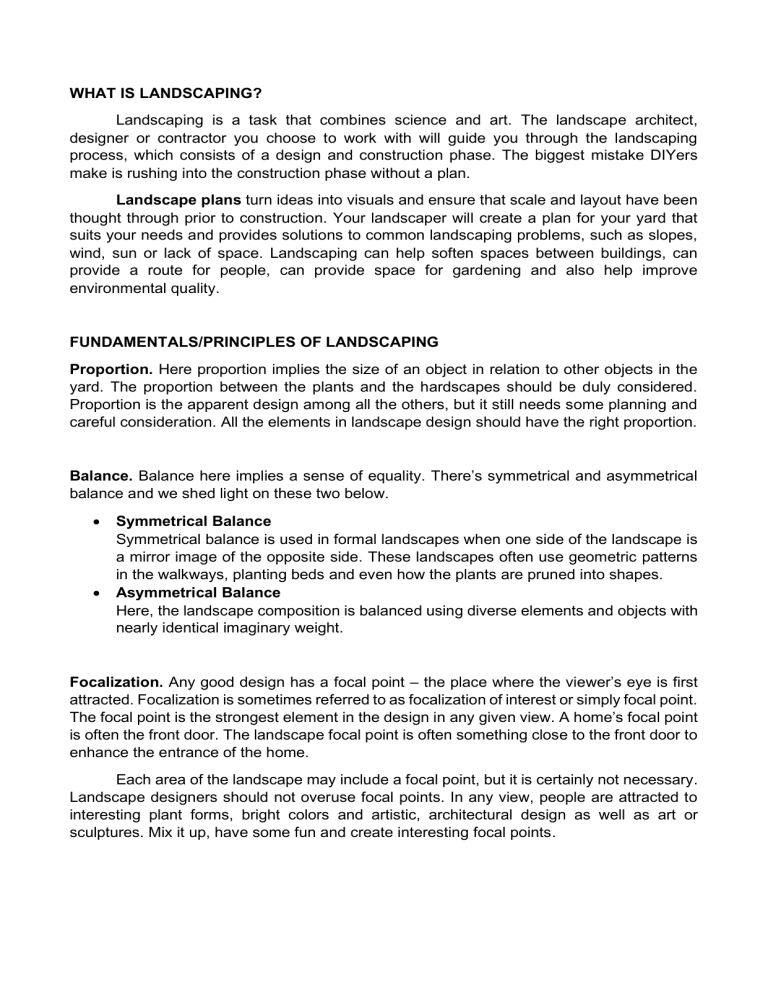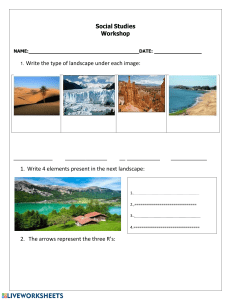
WHAT IS LANDSCAPING? Landscaping is a task that combines science and art. The landscape architect, designer or contractor you choose to work with will guide you through the landscaping process, which consists of a design and construction phase. The biggest mistake DIYers make is rushing into the construction phase without a plan. Landscape plans turn ideas into visuals and ensure that scale and layout have been thought through prior to construction. Your landscaper will create a plan for your yard that suits your needs and provides solutions to common landscaping problems, such as slopes, wind, sun or lack of space. Landscaping can help soften spaces between buildings, can provide a route for people, can provide space for gardening and also help improve environmental quality. FUNDAMENTALS/PRINCIPLES OF LANDSCAPING Proportion. Here proportion implies the size of an object in relation to other objects in the yard. The proportion between the plants and the hardscapes should be duly considered. Proportion is the apparent design among all the others, but it still needs some planning and careful consideration. All the elements in landscape design should have the right proportion. Balance. Balance here implies a sense of equality. There’s symmetrical and asymmetrical balance and we shed light on these two below. • • Symmetrical Balance Symmetrical balance is used in formal landscapes when one side of the landscape is a mirror image of the opposite side. These landscapes often use geometric patterns in the walkways, planting beds and even how the plants are pruned into shapes. Asymmetrical Balance Here, the landscape composition is balanced using diverse elements and objects with nearly identical imaginary weight. Focalization. Any good design has a focal point – the place where the viewer’s eye is first attracted. Focalization is sometimes referred to as focalization of interest or simply focal point. The focal point is the strongest element in the design in any given view. A home’s focal point is often the front door. The landscape focal point is often something close to the front door to enhance the entrance of the home. Each area of the landscape may include a focal point, but it is certainly not necessary. Landscape designers should not overuse focal points. In any view, people are attracted to interesting plant forms, bright colors and artistic, architectural design as well as art or sculptures. Mix it up, have some fun and create interesting focal points. Simplicity. Simplicity is what the name implies – simple. Keeping landscapes simple, not cluttered or fussy is always a good practice. This is not the opposite of complexity. Many landscapes have very complex features, including the architectural design, water features and extensive lighting features. Landscapes that make people happy and comfortable avoid using too many colors, shapes, curves and textures, but in no way does this mean simplistic, boring or lack of imagination. Color. Colors help give your landscape design vibrancy. Warm colors like red and orange make your landscape pop and seem to beckon on you, making an object appear closer. Blue and green colors seem to move away from you and are used to create perspective. Repetition. It’d be best if you create familiar patterns and sequences in the landscape, and this is where repetition comes in. Landscape design elements or specific features of it can be repeated throughout your yard. Too many objects that are unrelated to other designs can make your landscape design appear unplanned and cluttered. But try not to overuse an element as it’ll make the overall look seem monotonous and uninteresting. Unleash your creativity by using these principles to design your landscape. Consider utilizing colors, contrasts, and lines to help influence your landscape design. DESIGN FACTORS OF LANDSCAPING Landscaping design weaves together various factors to bring about a finished landscape. Each factor plays a vital role in the landscape’s whole architecture and ecosystem. Here is a list of factors that go into designing a landscape. Type of soil. Soil composition is an important factor of landscaping as it affects the variety of plants that can be planted. When it comes to soil composition, several aspects come into play such as the pH level of the soil, texture, drainage, etc. As for the texture of your soil, ensure that you first identify whether your soil is rocky, sandy or full of clay before deciding on the type of plants to include in your landscape. Drainage system of the landscape. The water drainage of the yard is one of the vital factors while planning your landscape. The best landscape design must have proper water movement away from your home. The water flow movement will be towards the other areas of the yard. View guidance. Low height plants show hindrance to the entrance of the place but the view is not obstructed. Medium height plants show hindrance to the entrance as well as the view of the place. Thus, plantation matters according to the usage of the place. The amount of space. A space is equivalent to a canvas for designers to work on. Depending on the workspace available, you will have to precisely plan out your design by taking into account the measurement of the space and also the dimensions of the elements you wish to introduce into the space. These components can include anything from fountains, ponds, garden beds, decorations, walkways, gazebos and etcetera. Water. Water can be both a boon and a bane when it comes to landscapes. Occasional showers of rain can save us the time and energy of keeping our gardens watered. However, torrential rain has the potential to cause damage to a landscape. A landscape can become waterlogged and surrounding plants and materials can be damaged. One way to overcome this problem is to plant more trees in areas more prone to flooding as trees can absorb the water. Other than that, in cases where your landscape is situated on a slope, you can construct a retaining wall to prevent soil erosion caused by the movement of water. IMPORTANCE OF LANDSCAPING IN ARCHITECTURE In the field of architecture, Landscaping together with site planning is the design element that ties these elements together and makes use of the spaces surrounding the building. Whether we are designing a single-family residence or a large-scale public building, landscaping ties the building to its surroundings and creates outdoor spaces that invite people to stop and spend time or pass through to define a building entrance. Architecture is often associated with aesthetic and functional design, whereas the link to nature and reduced impact on the environment is still missing in most new buildings. architecture needs to learn from landscape architecture how to not only design something new, but also how to respect the natural initial elements of the site, as well as the long-term changes and the impact on the urban context. Through different landscape architecture design principals, the negative effects of architecture on its surroundings can change for the better. Modern buildings often seem to scream for the need to get back to our roots in nature. EXAMPLES OF LANDSCAPING 1. Addition of ornamental, edible, native or other types of landscaping plants. Well-designed edible ornamental landscapes, also called foodscapes, provide landowners with aesthetically pleasing, multipurpose gardens that provide food, color, and cover year-round. Not only can these landscapes provide a source of healthy, locally grown food in urbanized communities, they can also promote energy and water conservation, improve food security, and provide wildlife habitat (Çelik 2017). By converting conventional yards into sustainable, edible ornamental landscapes that utilize the principles of Florida- Friendly Landscaping™, we may quell some of the health and environmental impacts of rising population growth and urbanization (Çelik 2017). Many plants that are healthy for people are also sources of food and habitat for pollinators and other beneficial insects. Some of the best plants to include in edible gardens are already a part of the native landscape and are already perfectly adapted to your area’s climate. 2. Changing the shape of the land through grading, backfilling, mounding, terracing, etc. Changing the shape of your land happens first. It can mean grading areas to flatten them, backfilling holes with dirt and stone, building up mounded sections or creating terraces. It can also involve moving large landscaping boulders and stones into place. While this is going on our tradesmen install the correct drainage to prevent flooding, as well as irrigation systems and buried plumbing or electrical lines. 3. Constructing fences, patio covers, walls, decks, raised planters or other built features. The entrance and front yard are the most public parts of most people’s yards. You can design the entire front yard for public viewing or – because of small lot size or a need for privacy – enclose parts of it with plants, fencing, or both. Trees, shrubs, flowers, lawns, fences, and other landscape structures should fit in with the neighborhood’s character. When designing gardens and landscapes with uneven or sloping ground, you can use decks to create flat, usable landscape areas. While it's common to keep the natural wood, if you want a deck with a difference, consider a dark stain or whitewashed finish instead. References What is Landscaping? - Landscaping Network What is Landscaping and Why it is Important? -BuildersMART Understanding the Basic Principles of Landscape Design | Eden Lawn Care and Snow Removal (edenapp.com) Principles of landscape design - MSU Extension What are the design factors for landscaping? - BSG LANDSCAPE & CONSTRUCTION PTE LTD Factors to be considered before planning your landscape design | by Landscape Professionals | Medium What Do Architects Need to Learn from Landscape Architects? (land8.com) ENH1354/EP618: Edible Ornamental Landscaping Guide for North-Central Florida (ufl.edu) Edible Landscaping - MyGardenLife Landscape Architecture Design in Broomfield, CO (outdoorcraftsmen.com) Designing Gardens & Landscapes - Free Tips & Tricks | DIY Designs


